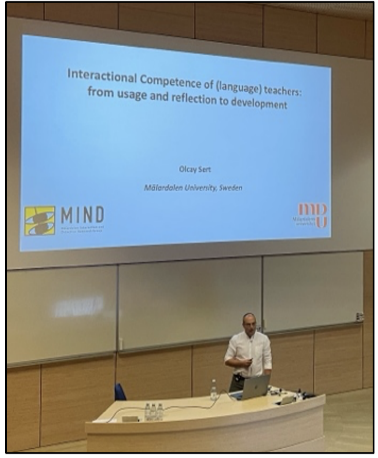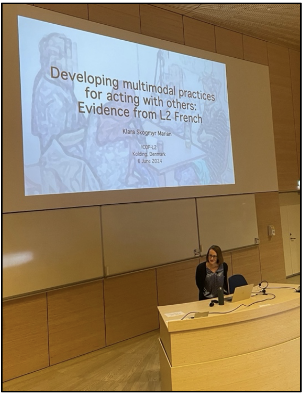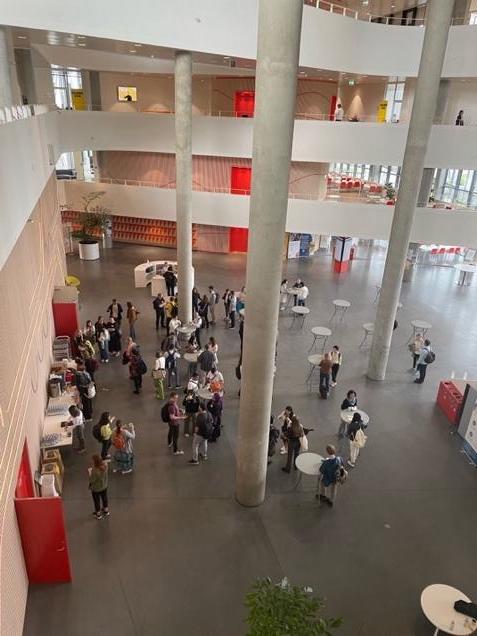Tiziana Kowalczuk & Melissa Juillet
University of Neuchâtel
TDL (Thinking, doing, learning) took place at Kolding University from June 3-5, 2024, under the organization of Søren Eskildsen. It was aimed at researchers in usage-based linguistics and second language acquisition (SLA), encompassing diverse interests such as multimodality, multilingualism, language learning and applications in language education. The event’s goal was to advance both empirical and theoretical understanding, raising significant questions about the nature of language, learning, and cognition, and exploring how multilingualism and different modalities impact L2 education. The program included plenary sessions with various foci, panel discussions, parallel talks, and workshops, fostering a comprehensive exchange of ideas and research.
As a “conference appetizer,” Plenary 1, “Usage-based L2 development research and L2 education: Can learner corpora provide relevant insights?” by Ute Römer from Georgia State University, set the tone for the event by exploring the intersection of usage-based approaches to second language development and the potential of learner corpora. Her talk addressed how these corpora can offer valuable insights into L2 acquisition, bridging the gap between research and education in meaningful ways.

Ute Römer’s opening plenary
She presented three case studies: the development of formulaic language among Asian learners of English, phrase-frames in L1 Chinese learners’ English across proficiency levels, and verb-argument constructions in L1 German and Spanish learners’ English. These studies revealed insights into how learners’ proficiency levels impact the variability, predictability, and functions of these linguistic structures. Römer suggested using these discoveries to improve language teaching by creating custom methods that use learners’ responsiveness to input and incorporating corpus-based insights into teaching materials. Her talk underscored the importance of bridging research and pedagogy in applied linguistics to advance effective language education strategies.
Following the plenary, the day continued with several parallel sessions exploring a variety of themes. One major focus was on multimodality, emphasizing how the integration of gestures can significantly enhance interactional competence and teaching effectiveness across diverse educational and professional contexts. Presentations discussed the practical applications of these multimodal approaches, such as in teaching chemistry in Japanese EMI contexts (Evnitskaya & de Boer) and understanding language use in multilingual settings (Tůma).
Another significant focus was on classroom interaction and instructed L2 learning. Discussions delved into the dynamics of language acquisition in educational settings, emphasizing how pragmatic practices and the learning environment influence L2 proficiency. Research in this area provided insights into how language education can better cater to social (Andersen) and cognitive aspects of language learning (Campbell-Larsen) and thereby foster a more comprehensive approach to language education.
The second day of the conference was once again filled with numerous presentations, addressing a wide range of themes such as teaching and education, interactional competence in virtual settings, and construction learning. On this specific topic, the conference delved into construction learning in L2 contexts, which focuses on how learners acquire and use language through form-function pairings like grammatical patterns or idiomatic expressions. Studies presented empirical evidence on the evolution of specific linguistic constructions in languages like Chinese (Jen), English (Finn), Norwegian (Horbowicz & Nordanger), or Icelandic (Eskildsen & Theodórsdóttir), providing detailed analyses that inform targeted teaching methods and curriculum design to support natural language acquisition processes.

Rasmus Steinkrauss’ plenary
The day was punctuated by the 2nd plenary, “Variation and Variability, Competition and Change: A dynamic usage-based approach to language development”, presented by Rasmus Steinkrauss from the University of Groningen. Central to his presentation was the view that language development is construction-based, individualized, and influenced by multiple factors including language input. Steinkrauss argued against a static, numbers-focused approach, urging instead to interpret data in terms of action and function.
Drawing on dynamic systems theory, he highlighted the importance of variability in understanding language acquisition, illustrating how different learner groups exhibit varying degrees of variability that reflect the stability and adaptability of their language systems. This perspective challenges traditional views by emphasizing the evolving, nonlinear nature of language development, where grammar emerges as a solution to communication challenges rather than a static structure. Steinkrauss’s talk underscored the value of integrating dynamic approaches into language studies to better capture the complexity and variability inherent in linguistic behaviors.
In addition to the sessions and the plenary, the second day included an afternoon focused on early-career researchers, featuring three workshops aimed at developing essential skills and fostering professional growth. The sessions, titled “Data visualization and transcription” (Wagner, Davidsen, Schümchen), “Materiality of interaction” (Lilja), and “Navigating the publishing world” (Kunitz, Pekarek Doehler, Sert) offered hands-on training in key research techniques and strategies.

Data visualization and transcription workshop’s participants
These workshops provided participants with practical tools to enhance their ability to conduct, analyze, and effectively communicate their research, contributing to the overall quality and impact of applied linguistics studies.
The second day concluded with Plenary 3, “Giving a hand to learning: Pedagogical gestures in the language classroom”, presented by Marion Tellier from Aix-Marseille Université. Drawing from studies in language teaching, gesture studies, and cognitive science, Tellier highlighted how teachers employ body language – such as gestures, gaze, posture, and facial expressions – to enhance classroom functions like information delivery, assessment, and management of interactions. She demonstrated that these gestures play a key role in aiding learners’ comprehension and memorization of language content.

Marion Tellier’s plenary
Supported by empirical evidence, Tellier presented research showing how gestures effectively help in accessing meaning and improving vocabulary retention. She showed that experienced educators integrate these gestures seamlessly into their teaching practice, while novice teachers often face challenges in utilizing them effectively, highlighting the need for awareness and training. Tellier emphasized the developmental aspect of gestures as a professional technique and outlined criteria – such as visibility, iconicity, relevance, kindness, and consistency – to optimize their pedagogical impact. Ultimately, her talk highlighted how gestures, alongside speech, are integral to pedagogical discourse, crucial for fostering learning environments conducive to comprehension, management, and effective feedback in language classrooms.
The third day was dedicated to exploring three key themes: interactional competence, identity, and teaching and education. We were fortunate to be part of the invited panel on interactional competence, organized by Sophia Fiedler and Samuel Schirm, where presenters showcased research highlighting the role of grammaticalization in the acquisition of L2 linguistic constructions. Studies focused on constructions such as ich weiß nicht (‘I don’t know’, Schirm & Fiedler) in German, tu vois (‘you see’, Skogmyr Marian), tu sais (‘you know’, Juillet & Kowalczuk) and je sais pas (‘I don’t know’, Pekarek Doehler) in French, and 那 na (‘that’, Wang) in Mandarin, illustrating how speakers adapt their language practices to meet local communicative needs. By tracking the acquisition of these constructions, the research demonstrated a concrete evolution in the use of these expressions as discourse markers, highlighting the dynamic nature of interactional competence in response to specific conversational contexts. The discussion, led by Betz and Nguyen, raised pertinent questions about how to explain the different trajectories of language acquisition and how such research can contribute to a better understanding of the process of functional diversification in language use.
Additionally, innovative pedagogical approaches and their impact on language learning were discussed extensively. Presentations highlighted dynamic and multimodal strategies such as task-based language teaching (Maslo) and peer interaction to transform L2 education (Aziez, Pfenniger & Verspoor). Discussions underscored the importance of contextually relevant and engaging teaching practices that promote inclusivity and effectiveness in language learning environments.
Overall, the conference provided a platform for researchers to exchange ideas and insights into enhancing L2 learning through empirical studies and innovative pedagogical approaches. It underscored the dynamic nature of language acquisition and the importance of adapting teaching strategies to meet the diverse needs of learners in various educational settings. Participating in this conference as an early-career researcher was a great privilege. The diversity and depth of the topics presented have provided invaluable insights and will undoubtedly serve as a source of inspiration for our own research projects.
ICOP-L2

Closing TDL, Opening ICOP-L2
The fourth international conference ICOP-L2 (Interactional competences and practices in a second language) explored diverse facets of second language interactions and their enhancement through various tools and practices, emphasizing both theoretical and practical perspectives. ICOP-L2 was scheduled immediately after TDL, reflecting their shared focus on interaction, multimodality, and second language learning.
This arrangement enabled dynamic exchanges between disciplines and perspectives, as many participants attended both events. Olcay Sert’s plenary session connected the two conferences, serving as the closing plenary for TDL and the opening plenary for ICOP-L2.
In Plenary 4, Olcay Sert (Mälardalen University) introduced his talk (Interactional Competence of (language) teachers: from usage and reflection to development) by providing an overview of what investigating the development of second language interactional competence (L2-IC) can look like. He informed us that research can either focus on 1) L2 learning and development, 2) Language testing and evaluation, 3) Teaching L2-IC or 4) Language teacher education and professional development (the development of Classroom interaction competence, CIC).

Olcay Sert’s plenary
In his plenary, he described what Classroom IC (CIC) is – the ability to use interaction as a tool for mediating and assisting learning – and argued that CIC can be observed in the way a teacher: maximizes interactional space, gives instruction, mobilizes students responses, responds to learners, manages student-initiated sequences, deploys embodied, semiotic resources, or multilingual resources or manages claims of insufficient knowledge
The remainder of the day focused on topics related to materiality, classroom interactions, and assessments.In the panel on materiality (Lilja & Urbanik), presentations addressed various uses of objects in interactional sequences, such as in repair sequences (Lilja et al.; Wagner & Eskildsen), explanatory sequences (Urbanik & Svennevig), and service encounters (Eilola). Objects serve as crucial mediators in language learning, scaffolding comprehension and engagement. The session on classroom interactions explored topics like storytelling practices (Tan; Imamura, Looney & Park). As for assessments, Leyland & Walper, for instance, examined the sequential organization of a placement test.
On Day 2, there was a second panel on materiality (Kunitz & Majlesi), focusing on the use of objects for learning, teaching, and testing. For example, Hoskins’ presentation examined the use of photos and objects in educational contexts. In the afternoon, a session on classroom multimodality explored the role of multimodality in explanations (Tiermas), repair (Badem), and storytelling (Jen).
A key topic of the day was the emergence of linguistic structures in L2 over time, which was discussed in several presentations, a dedicated panel (L2 Grammar-for-Interaction), and Klara Skogmyr Marian’s plenary talk. In the morning, presentations focused on various grammatical structures, such as nominal subordinates (Horbowicz & Nordanger) and the grammatical formats of explanations (Fiedler). The morning concluded with Plenary 5, by Klara Skogmyr Marian from Stockholm University, who presented a talk on “Developing Multimodal Practices for Interacting with Others: Evidence from L2 French.”

Klara Skogmyr Marian’s plenary
She presented three studies underscoring the importance of a longitudinal and multimodal approach in studying language acquisition. In one of them, she examined the evolution of linguistic resources that speakers use to accomplish the same interactional actions over time. For instance, she illustrated how a L2 French speaker, Aurelia, initially used non? (‘no?’) to elicit interlocutors’ reactions, and later incorporated new resources such as tu vois (you see). The plenary highlighted the dynamic nature of language acquisition and the value of examining it through a longitudinal and multimodal lens.
The focus on linguistic structures continued into the afternoon, with presentations on agreement and disagreement formats in L2 (Eskildsen), as well as on fixed constructions such as parce que (Juillet), en fait (Skogmyr Marian & Skogmyr Marian), and et (.) oui (Konzett-Firth). At the same time, Kääntä & Berger organized a panel on workplace interactions, featuring presentations on training in the healthcare sector (Berger, Horlacher & Wenger; Filliettaz & Berger) and teacher training (Heller & Morek; Kääntä & Nikula). Before the end of the day, Malabarba & Oittinen organized a panel on Embodiment & Tech-Rich Environments, with discussions that underscored how physical actions and technology intertwine to create immersive learning environments. For example, Gudmundsen studied showings as a repair strategy in video-mediated L2 interaction.

Hanh T. Nguyen’s plenary
The development of interactional competence – understanding how to use language effectively in various professional contexts—was emphasized as crucial for L2 learners. This topic was also brought out in the final plenary, plenary 6 by Hahn T. Nguyen, from Hawai’i Pacific University, with her talk on Interactional Affordances for L2 Competence Development in Workplace Interaction. Choosing Hanh T. Nguyen to close this conference was a brilliant decision, as she effectively encapsulated many topics discussed during ICOP 2024.
The central question of her talk was: why does social interaction trigger development? She provided four answers through four studies, all based on longitudinal data of interactions between hotel employees and clients. These studies illustrated how the employees developed different ways to accomplish the same interactional actions over time. In one study, for example, she showed that development can be seen through the evolution of the staff member’s responses to guests’ assessments of the hotel. Initially, the staff member responded with a simple “yes” or “yes, thank you.” Over time, she expanded her responses by providing additional information, such as the number of rooms of the hotel, or even incorporating humor.
Overall, the conference underscored the importance of materiality, multimodality, and contextualized interaction in L2 learning. It highlighted how classroom interaction, professional training, and technology-rich environments collectively contribute to the development of interactional competence. The discussions also covered assessment, epistemics, and understanding, pointing to the need for comprehensive approaches in L2 education that address both the cognitive and social dimensions of language learning.
Closing ICOP-L2

After 3 plenaries, 5 panels and 72 presentations, ICOP-L2 came to an end, Søren announced the next ICOP-L2 in… Newcastle (2026), organized by Christopher Leyland. We are already looking forward to it! And we thank Søren again for having us in Kolding and its wonderful campus.
